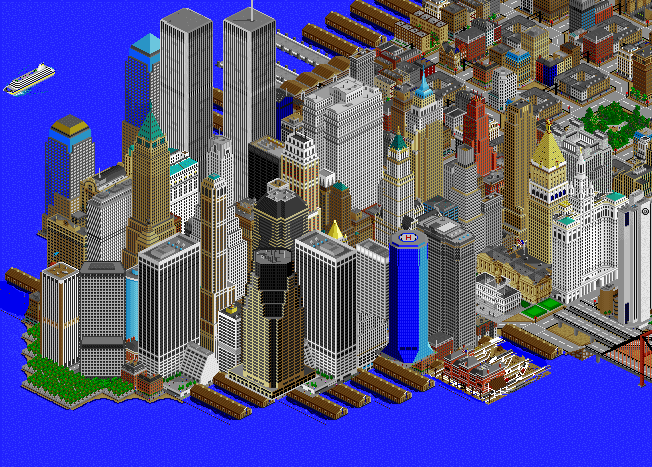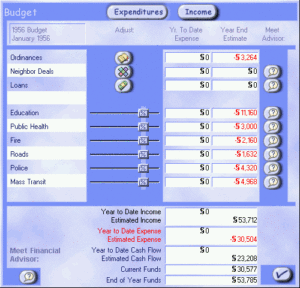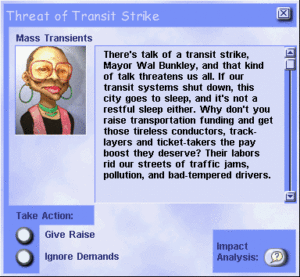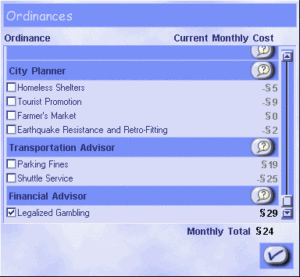
(SimCity image via nycj blogspot)
I was eight years old when I first encountered a computer game called SimCity. The general premise of the game was that you were the mayor of a virtual city, and you would use game money to create a place for communities of “Sims” to live.
First you set up basic infrastructure like roads, pipes, and zoning and soon after, the “Sims” would arrive to build buildings and pay taxes. As tax revenue flowed in, you would use it to make citywide improvements by establishing public infrastructure like schools, hospitals and parks. The more robust your city’s services, the more Sims would want to live there, and the more tax revenue would roll in. As the game progressed and your city grew, your decisions as mayor became increasingly complex. However, an easy-to-use interface simplified the tasks and made the whole experience a lot of fun.
That was 1994, and at the time, I assumed that one day, my neighbors and I would all have a hand in understanding and shaping New York City through tools and interfaces like SimCity’s. Apparently I wasn't the only one. A recent story in the LA Times claims that "'Sim City' inspired a generation of city planners."
As the internet was getting increasingly popular, my confidence in that idea strengthened. How difficult could it possibly be for the biggest city in the world’s richest country to create “Sim NYCity”?
Apparently it's quite difficult -- not from a technical perspective, but from an organizational development one.
Technically, government agencies have the vast majority of the data SimCity offers to viewers, such as geographic information like zoning and elevation; statistical information like crime and graduation rates and population; and infrastructure monitoring like traffic, electricity use, water flow rates, etc. But bringing it all together to give the residents an intelligible, (relatively) real-time dashboard for seeing their city operate clearly just isn't a priority.
Thanks to the tireless work of open source software developers and open government advocates, we don't have to wait for our city to organize this information for us. We can -- and should -- begin to do it ourselves.
Here are a few of the features that would make "SimNYCity" such a valuable contribution to civic life.
Interactive Community Maps
The centerpiece of the system is a map similar to Google Maps or the City's Planning Lab's new Community District Profiles website. It would have highly curated data layers that display education, health, police, fire and mass transit indicators (in SimCity parlance: data maps), as well as useful demographic information of residents.
Anyone could click a few layers on and off to see which neighborhoods have access to which services, and which don’t. Users could select which facilities they’d like to see added to an area, and then receive a projection of how the addition of such a facility would impact access in the neighborhood. Of course, accurate projections would be difficult to create, but basic estimates wouldn’t be, and more importantly, the existence of such a tool would whet the public’s appetite for more information and involvement in planning processes.
Citizen-Driven Budgets

[Offering opinions on the budget could be as easy as pulling a few sliders]
Managing the budget was one of the most important jobs of the mayor in SimCity. The tool for doing this was similar to a mortgage calculator. Income and expenses were presented with about 10 line items each, and you could pull the slider in one direction or another to change funding allocations and see how those allocations impact the entire city's budget.
We should offer a similar tool to New Yorkers. We can synthesize the New York City budget from thousands of line items into a dozen or so, enabling anyone to quickly see how money flows in and out of the city’s government. Then we can invite them to create their budget by pulling sliders. As they do, the city’s budget projections change.
So, if someone would like to increase the education budget they would toggle education to the right. Then they might adjust revenue by increasing taxes to balance the budget. Bonds could be included into the mix too by showing a list of public bond offers and requests. This type of tool would allow New Yorkers to create the budgetary mixes they want to see, and they can share it with others.
We could also generate statistics about all the different budgets New Yorkers create to develop insights about how the city’s budget could more accurately reflect the values of the city's residents.
Decision-Making Moments

[City advisers could send out messages to New Yorkers and ask for their direct feedback]
When time sensitive decisions were needed in SimCity, a popup would appear with a message from an adviser asking the mayor for a decision. “SimNYCity” could work similarly by providing citizens with more opportunities to indicate their preferences on key civic issues.
For example, when a controversial zoning change is being proposed, an alert from the Commissioner of City Planning could be sent to SimNYCity users saying something like: "Residents are wondering what you plan to do with the Bedford Armory. Here's some information about the various interest groups. Do you think the current proposals should move forward or should it be rewritten?" Users could then say what they think.
This type of feedback could provide useful information for city leaders that they could incorporate into their decision-making processes. A similar workflow could be used for legislative and administrative decision-making.
Moving Beyond the Vote

[Imagine if all the active and proposed city ordinances were laid out in a simple list]
Our current democratic processes are, unfortunately, failing New York City. Less than 25% of eligible New Yorkers voted in the 2017 election cycle, in which over 95% of incumbents won their primaries and went on to win uncompetitive general election races. This means that a very small group of Democratic Party insiders are the people determining who will serve in New York City government. That isn’t very democratic, and it's the main reason so few New Yorkers show up to the polls.
We don’t have to wait for deep reforms to our city’s democratic processes before we start experimenting with new and innovative ways to provide participatory democratic experiences to New Yorkers. We can offer citizens methods for engagement right now - and if these methods turn out to be popular, then we can organize the public to pressure existing politicians into incorporating these methods into their decision-making processes.
These are just a few interfaces SimCity has for making cities and their governments more legible, and interacting with them more enjoyable. The technical hurdles to implementing similar interfaces for the city are certainly significant, but not impossible to overcome.
Planning Labs, a digital service organization within New York City’s city planning agency is building open source software and open data resources that could power many of the complicated mapping elements. Furthermore, New York City's Open Data law mandates that much of the information we'd need from the government to build such a system is being published to the city's official Open Data Portal.
Exploring what that data is and how it can be connected together to build the type of deep data resources needed to power interfaces similar to SimCity's is the next step -- and it's work my team at Sarapis has begun to do by extracting and connecting nearly a dozen (and counting!) city datasets together to create data-driven government agency profiles that will make it easier for civic-minded people, especially journalists, to navigate and use for their work.
Through this process, we’re learning what data is and isn't available, how that data can be connected together and visualized to deliver insights to our users, and what next steps need to be taken on the long journey of delivering New Yorkers a SimCity style interfaces for their city.
***
Devin Balkind is the president of Sahana Software Foundation, founder of Sarapis.org, and a former candidate for New York City Public Advocate. He speaks regularly at conferences around the world about using technology to overcome environmental and political crisis. On Twitter @DevinBalkind.
***
Have an op-ed idea or submission for Gotham Gazette? Email This email address is being protected from spambots. You need JavaScript enabled to view it.




